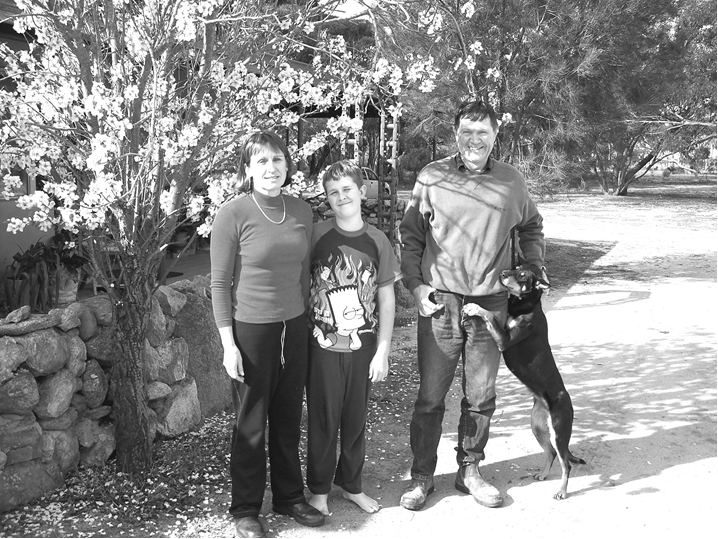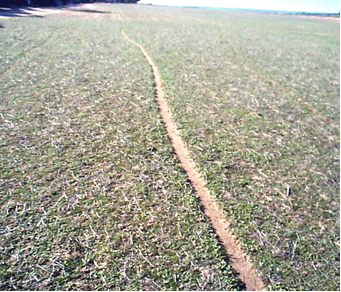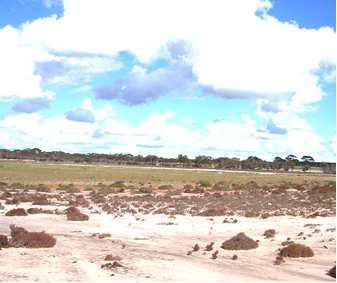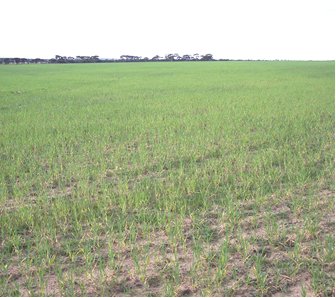By Jon Bradshaw © John Bradshaw, Biodynamic Growing Magazine, www.bdgrowing.com
Bernadette, David and John Cashmore
John Cashmore has lived on his farm, Nyonger, a 4800 acre property 40 kilometers east of Hyden, Western Australia, all his life. The farm is roughly five hours drive east of Perth and is only one property away from the edge of farming in Western Australia, the rabbit proof fence. Average annual rainfall is only 325 millimeters or 13 inches. John took over full management of the farm from his father 20 years ago and runs it together with his wife Bernadette and son David.
The property was first settled under a government scheme that required complete removal of all trees. John and his father kept filling in the forms saying that full clearing was “on the program,” but managed to retain 20 percent of the native bush. Now, in more enlightened times, they have received a grant enabling them to fence off half of that area and have financed the rest of the fencing themselves.
John’s father was always anti-chemical, but every year they had to use more chemicals, and every year there were more problems. Salt pans and scalds were expanding rapidly, and during drought periods the soil would blow. John could see that they were progressively losing the farm. Somehow he heard about Biodynamics, and read the first two volumes of Alex Podolinsky’s Bio-dynamic Agriculture, Introductory Lectures. He was excited by what he read and saw it as the answer he was looking for. When Alex came to look at the farm, he was very guarded, and told John and Bernadette that it might take a long time to bring the farm back. Nevertheless, they persisted and began spraying BD500 and using Biodynamic management practices in 1992. In 1995 they gained Demeter Biodynamic certification with the Bio-dynamic Research Institute, Powelltown, Victoria. The soil improvements under Biodynamics have far exceeded their expectations.
Biodynamic Results
The most dramatic result of Biodynamic farming has been the enormous improvement in salt affected areas on the farm. The aerial photos published in Biodynamic Growing magazine No. 3, December 2004 (www.bdgrowing.com) show the improvement in Cashmore’s salt areas and the corresponding worsening in the upstream neighbour’s salt areas from 1994 to 1999. John and Bernadette took me over many of these areas and pointed out how much further improvement had taken place since 1999. Areas that had been completely bare (even in one paddock, covered with a 1 centimeter crust of white salt) then were now in various stages of recovery: some fully recovered, back to cropping and good pasture, and some not quite there, but growing various ground covers such as blue-bush (sheep love it) that wouldn’t grow before.
As with most large properties, there are a variety of soil types on the Cashmore’s property. The worst are the white sands, very vulnerable soils that can’t be cultivated because they will then simply blow away. Even sheep walking on them in summer can cause erosion. Since Biodynamics, the white sands are a mass of roots and can safely be cultivated with no problems.
Soil conversion - original white sand at bottom
Another problem soil is the Gimlet soil, so called because Western Australian Gimlet trees, Eucalyptus salubris, grow there. These soils are the complete opposite of the white sands, being very tight, heavy blue clays. Gimlet areas are called “one day country” because they are too wet to work one day and too hard the next. No one can grow good crops and pastures on Gimlet soils. Under Biodynamics, Cashmore’s Gimlet soils have changed from blue clay to brown friable soil down to 150 millimeters, and are very soft to walk on. We dug down and found the original clay below 150 millimeters, but even this was well penetrated by roots. The Cashmores can now grow good grain crops and pastures on their Gimlet soils!
Soil conversion, Gimlet clay soil
The lighter, better Salmon soils, so named because Salmon trees, Eucalyptus salmonophloia, grow there, have also improved dramatically. Non-wetting soils that were a nightmare to manage before, and that no chemicals could make productive, are a lot better under Biodynamics. Airstrips on the farm that were completely dead are now difficult to grade because of the massive root systems under the thriving pasture.
The soils in general are much softer now – in summer when John and Bernadette drive on some paddocks, the wheels sink in 100 millimeters, but when they come back four weeks later, the wheel ruts have lifted and disappeared, such is the level of biological activity. The sponginess of the soils is very different now to what they knew before Biodynamics. John is able to tow much larger cultivators relative to the horsepower of his tractors than his neighbors can because of the softness of his soils.
As quantified in the tests carried out by Latrobe University (Victoria) scientists and published in Biodynamic Growing No. 3, Cashmore’s soil is better structured than his neighbors' soil, absorbs much more water (holding twice as much due to much higher humus levels), has twice the organic carbon level, exhibits a much higher level of biological activity, and has over six times more nitrogen (despite using no fertilizers). Cashmore’s crops stay green for six weeks longer than his neighbors do. In 2004, the area only received 50 millimeters of rain in spring, yet Nyonger pastures stayed green right to the end of the year. By comparison, the neighbor’s pastures dried off early and were brown until April.
Latrobe University also did comparative tests in the native bush areas that are not sprayed with BD500. These tests showed that BD500 is bringing about dramatic improvements beyond what nature can do.
In a very interesting illustration of the importance of plants feeding from the soil colloidal humus using fine white hair feeder roots, rather than through the soil water with the thicker, more vertical water uptake roots, John showed me a patch where a sheep had died some time ago, and rotted into the soil, releasing water soluble nutrients. The grass there was rank and darker green. The sheep wouldn’t eat it because it was unpalatable. John dug into the soil there – there were no fine hair feeder roots, only water uptake roots, and the soil structure had gone backwards compared with the surrounding soil.
Pasture, August (last month of winter)
Cashmore’s, 18th April 2004
Neighbour’s 18th April 2004 - nearby paddock, same soil type, same history and current use
Cashmore’s 6th July 2004
Neighbor’s, 6th July 2004. Nearby, same soil type, same history and current use.
Recovering salt pan – the green pasture was the same as the white foreground five years ago
Cropping
John and Bernadette grow about 800 acres of barley and 300 acres of oats, with the balance in pasture. Although it was late winter and the pasture was very short, one could see a high proportion of clovers. When clovers reach this level, John knows the soil is ready for a cropping phase. Alex Podolinsky told him that when clovers predominate (putting a lot of nitrogen into the soil), it is time for a crop. If a crop is not grown at this stage, non-leguminous grasses will predominate in the next season. Alex originally suggested a crop could be grown roughly one year in four, but initially they had to crop more often to alleviate compaction and keep the pastures going. Now they can crop less frequently. The level of clovers in the pasture is the guide rather than any fixed timetable. John hasn’t had to sow any clovers for 20 years. He uses no fertilizers on the property – any minerals are added only through self-selected mineral supplements made available to the sheep (see Mineral Supplementation below).
Weeds are not as big a problem in the crops now – apart from grazing fairly hard the season before a crop to reduce seed stocks in the soil, all weeds in the pasture are palatable to the sheep. Rye grass is detested by conventional grain growers, because it provides serious competition for the grain crop, but on Cashmore’s land the sheep control it by eating all the seeds – this does not happen on conventional properties. In John’s experience, rye grass predominates when soils have collapsed. When his soils are just starting to recover under Biodynamics they are predominantly rye grass, but after that they become balanced.
Wild radish is a very serious weed because its seeds are the same size as grain, and thus can’t be separated after harvest. The Cashmores have very few in their pasture, and those that do venture up are relished by the sheep.
We walked through a wide native shelterbelt on the boundary to a neighbor’s property. John and Bernadette were shocked to find a large paddock full of wild radish one meter high. The neighbor had sprayed it the previous year in order to grow a crop, but the radish had come back even harder. Weeds are nature’s way of redressing imbalances and spraying a weed will not solve the imbalance – nature will just keep trying and sending up the same weed. The neighbor’s sheep wouldn’t eat the radish either, so he had a real problem. The ground also was like concrete compared with Cashmore’s mattress-like soil.
Young barley crop
Applying the Biodynamic Preparations
In a 325 millimeters rainfall area, where the rain is concentrated in the winter months, it is quite a challenge to apply prepared BD500 to 4800 acres when conditions are right (soil moisture and warmth being the two most important considerations.) Adequate soil moisture for BD500 to work is sometimes only available for short periods in the year. (Note - prepared 500, is the Biodynamic preparation developed and proven effective by Alex Podolinsky. It combines 500 with the six Biodynamic compost preparations and is the only form of 500 used on Australian Demeter Biodynamic method farms worldwide, being more effective than 500 alone).
John has made a stirring set up (BD500 has to be stirred for one hour before application) consisting of 6X270 liter stirring machines operating in tandem on a large trailer. Each machine stirs 20 acres of BD500, so 120 acres is stirred in total. The trailer is stored in a shed, and can easily be moved outside for stirring – stirring must be done under the open sky. The stirred liquid is drained into the spray tank and refilled with 35 degree (celsius) water for the next stirring in 8 minutes!
John has a high speed tractor that pulls a 120 foot (37 meter) boom spray, hydraulically unwound, to spray the BD500 onto the soil. The tractor is capable of 70kph, but is driven at 30kph for spraying. John can cover 120 acres and be back to pick up the next 120 acres of 500 from the stirring machine within the required hour (after one hour too much oxygen is lost from the stirred liquid, and effectiveness is lowered). With this set up, John has applied up to 1800 acres in one day, but generally does 960 acres, spraying in the afternoon and evening. The spray rig is brightly lit for night spraying.
Mobile six bowl stirring set up (for BD preparation 500). Stirs 120 acres of 500 at a time.
Filling spray tank after stirring
Cashmore’s spray rig at work, 120 acres of 500 per batch.
Mineral Supplementation
The provision of mineral licks is a well recognized practice in both conventional and sustainable agriculture. It enables animals to obtain minerals that may be lacking from time to time in their feed. Animals are very intelligent at sensing what they need at any particular time.
John used the Hingee Rural formulations for some years, but of late has moved away from that system. He feels that some of the formulations are too expensive for the current economic climate. He feels that the Hingee formulations are more important for conventional stock, which need detoxifying and extra nutrition. The active feeder roots on John’s Biodynamic farm bring much more nutrition into his pastures, reducing the need for an expensive supplementation program. Also, the fact that they are formulations means that they are not truly self-selected minerals. For instance, an animal may have a particular need for copper or sulfur at some stage, but to get enough it may have to consume excessive amounts of the mixed supplement, getting more of other minerals than it requires.
John now supplies a range of minerals that he knows from experience are needed in his area, in separate containers in small weatherproof shelters in the paddocks. These include copper sulfate, prilled (granulated) sulfur, food grade phosphate, bicarb soda, gypsum, lime, starch, sugar, and apple cider vinegar. Some of the minerals are combined with sugar, but are also provided individually to give adequate choice. Interestingly, the less than 250 kilograms of food grade phosphate consumed by the entire flock in the last six years is the only phosphate applied to the 4800 acres!
The sheep consume more bicarb when they are on long grass or grain stubble – bicarb helps balance the pH of their digestive systems. Copper helps with worms while sulfur is very effective for lice (sulfur must always be granulated to avoid inhalation and resulting lung problems). Some sugar is needed with the sulfur to help them metabolize it. John advises caution with copper sulfate on its own, as there may be a danger of toxicity. He has a particular method based on experience over the years.
Under this system, the sheep are able to balance their diet themselves, every day - this is not possible when formulated licks are supplied, the constituents having been selected by a scientist in some remote office. John finds the sheep are very healthy, and excrete exactly what minerals are lacking in the soil. They tend to camp on degraded areas and this greatly assists in the rehabilitation of the soil in these areas. John has not drenched any sheep (only natural drenches would be used if they were required) in the last six years, and none have needed drenching.
Productivity and Economics
John says that Nyonger’s feed productivity is improving dramatically. He feels that the property can now comfortably carry 2000 to 3000 breeders, in conjunction with the grain crops. Last year in a good rainfall year he carried 5000 sheep on 2000 acres for nine months. The normal carrying capacity for the area is ½ sheep to the acre.
John’s unfertilized grain crops produce up to seven to eight bags per acre. Conventional farmers have got up to fourteen bags to the acre in the past, but this has dropped considerably in recent years. To get the extra production, the conventional farmers are spending over $200 a hectare on inputs (fertilizers and chemicals). John’s input costs are $2.50 a hectare for the BD500. His grain production is lower, but more profitable.
The economics of farming in Australia, where no subsidies are paid to farmers, are very problematic. In this low rainfall area, five hours by road from the coast, grain growing is barely profitable. The situation for conventional growers is far worse as they receive only 50 to 70 percent of the returns John and Bernadette receive for their Demeter certified barley, compounded by their far higher input costs.
As for their merino wool, growers received $22 a kilogram in 1950 for wool. In 2005, 55 years later, growers receive less than $5 a kilogram, and a dollar is worth eight times less now than it was 50 years ago. The Cashmores are managing, but most of their conventional neighbors are losing money.
To improve their situation, John and Bernadette are moving into marketing their own meat. Their Biodynamic lambs are tender and succulent, and they think that once consumers taste them they will come back again and again for more. However, a merino lamb takes 9-12 months to reach the desired carcass weight of 19 to 20 kilograms. Given the perilous state of the wool industry, John and Bernadette are seriously looking at Dorper sheep. The Dorper is a South African meat breed that has no wool. It handles dry conditions well and is very fast growing. It would give them three options – lambs could be marketed as early as four weeks, 19 to 20 kilogram wethers at four to five months, or thirty kilogram wethers at nine to twelve months. And no shearing or crutching costs.
John notes: “What I would really love to do is to make farming environmentally healthy, safe, harmonious and profitable – and I believe it is possible. I feel very privileged to be doing what I am doing – not many people get my opportunity. And in the end, if I don’t win, at least I’ve done my best.”
John and Bernadette Cashmore are doing immensely important work, bringing totally new vitality to nature over a large area, while producing food of the highest quality, without chemicals, and without wasting Earth’s irreplaceable phosphate reserves. By comparison, nature is in steep decline on the surrounding conventional farms, which produce food using environmentally damaging chemicals, and large amounts of phosphate and nitrates. Both conventional and Biodynamic farmers farm without subsidies, competing on a world stage where many countries subsidize their farmers at up to 60 percent of costs. For the sake of the future of farming and the environment in Australia it is imperative that the Australian government recognize and reward the Cashmores’ endeavors, and those of their Biodynamic colleagues.
Keep reading with a 7-day free trial
Subscribe to Josephine Porter Institute - Applied Biodynamics to keep reading this post and get 7 days of free access to the full post archives.
















